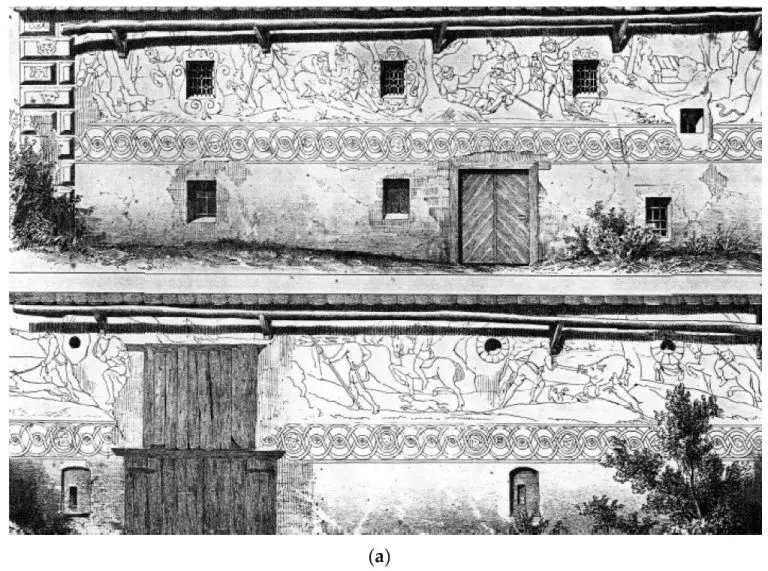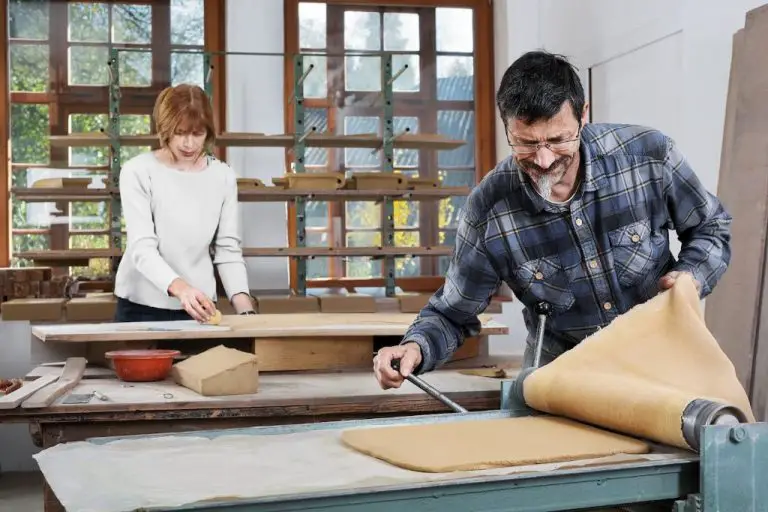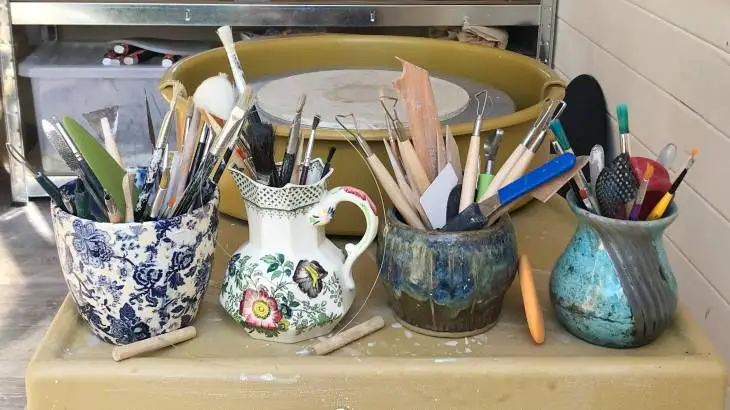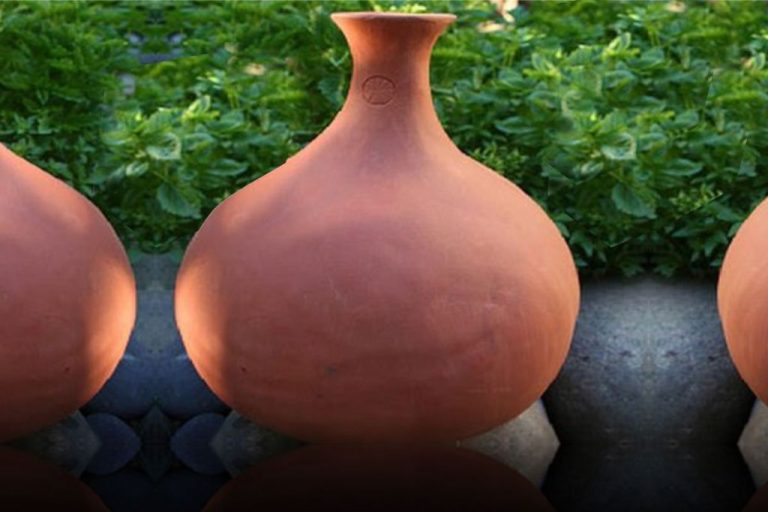How Much Water Do You Add To Powdered Clay?
Powdered clay is a dry clay mixture that requires water to be added before it can be molded or shaped. When mixed with water, powdered clay becomes a pliable material that is commonly used for pottery, sculpture, and other art projects. Knowing the proper amount of water to add is crucial for achieving the ideal clay consistency.
If too much water is added, the clay will become sticky and difficult to work with. On the other hand, not adding enough water will result in clay that is stiff, brittle, and prone to cracking. By following the manufacturer’s recommended water ratios and making adjustments based on the specific type and batch of powdered clay, you can produce clay that is smooth, flexible, and perfect for any clay project.
The water content affects the clay’s workability, durability, and drying time. Understanding the appropriate amounts of water to use with powdered clay allows artists to efficiently and consistently prepare quality clay that will hold its shape without becoming too wet or dry.
Recommended Water Ratios
When preparing clay, it’s important to add the proper amount of water to achieve the ideal consistency. Here are the standard recommended water ratios for the major types of clays used for modeling and pottery:
Polymer Clay
Polymer clay typically requires the least amount of water. Add 1 part water to 8 parts polymer clay by volume, or about 1 tablespoon of water per 8 ounces of clay.
Oil-based Clay
For oil-based clays like plasticine, add 1 part water to 2 parts clay by weight. If measuring by volume, use approximately 1/4 cup water per 1 cup of clay.
Earthenware Clay
For earthenware modeling clays, add 1 part water to 1 part clay by weight, or an equal amount of water and clay by volume. Start with 1/4 cup water per 1/4 cup clay.
Stoneware/Porcelain Clay
Stoneware and porcelain clays require more water. Use a 1:1 ratio by weight, or up to 1 part water to 0.8 parts clay by volume. Begin with 1/4 cup water per 1/5 cup clay.
Weight vs Volume Measures
When mixing water and clay, you can measure the amounts by weight or by volume. Both methods have their pros and cons.
Measuring by weight, using a kitchen or jewelry scale, provides more accuracy and consistency. The ratio of water to clay will be precise every time. However, scales can be expensive and measuring in grams may require some calculations if following volume-based recipes.
Measuring by volume using spoons, cups or graduated containers is more accessible for most home potters. But volume measures can vary based on factors like how densely the clay or water is packed. Overall, volume is best for rough estimates while weight is ideal for precision.
For beginners, volume measures provide a good starting point for experimenting with clay consistency. But for advanced projects, measuring ingredients by weight helps achieve reliable results.
Factors That Affect Water Needs
The ideal water ratio can vary significantly depending on the type of clay, the climate, the project you’re working on, and other factors. Here are some of the main considerations when determining how much water to add:
Clay Type: The natural composition and particle size of different clays require more or less water. For example, stoneware and porcelain clays tend to require more water than earthenware clays. Very dense, smooth clays like porcelain may need almost twice as much water compared to coarse earthenware clay.
Climate: Warmer, drier climates cause clay to dry out faster, requiring more water. Cooler, humid climates slow down drying time, so less water is needed. The season can also impact water needs if you are working outdoors.
Project Type: Sculptures, tiles, or handbuilt pieces require a stiffer clay with less water than projects thrown on the pottery wheel. Very thin or delicate structures need an extremely soft consistency with lots of water.
Drying Method: Allowing clay to dry slowly, such as covering it with plastic, needs less water than quick air drying. The faster clay dries, the more water it needs initially.
Clay Age & Condition: Older clay that has been reused tends to be drier and require more water. Brand new clay straight from an unopened package may have higher moisture content.
Personal Preference: With experience working with clay, artists develop personal preferences on the exact consistency they like to work with. The ideal water ratio comes down to what feels comfortable.
Signs of Too Much or Too Little Water
When working with clay, it’s important to pay attention to visual and tactile cues that indicate if your clay has too much or too little water added. Here are some key signs to watch for:
Too much water:
- Clay feels sticky, slimy, or slippery
- Surface appears shiny when smoothed out
- Clay drips or oozes when handled
- Form loses shape or details flow together
- Clay takes much longer to dry and harden
Too little water:
- Clay feels crumbly, dry, or cracked
- Surface appears rough, layered, or uneven when smoothed
- Clay won’t stick together well and falls apart
- Clay is difficult to mold without cracking
- Clay drying time is very fast
Paying attention to these visual and tactile signs as you work will allow you to adjust the water content to achieve the ideal consistency for your clay project.
Adjusting Water Content
If you find your clay is too wet or too dry after initially mixing the water, there are some steps you can take to adjust the consistency:
If the clay is too wet and sticky:
- Let it sit uncovered for a while to let some of the moisture evaporate.
- Knead in small amounts of dry clay powder until reaching the desired consistency.
- Add a few drops of lemon juice or vinegar while kneading to help firm it up.
If the clay is too dry and crumbly:
- Spritz water over the surface and knead it in.
- Add water by the teaspoon and knead until incorporated.
- Mist the clay with water, seal in an airtight bag, and let sit for 30 minutes.
Go slowly when adjusting water content to avoid over-correcting. Knead thoroughly after each adjustment to evenly distribute moisture. The clay should become a smooth, flexible dough that holds its shape. Test a small piece to ensure it has the right consistency before proceeding with your project.
Storing Prepared Clay
Once you’ve mixed water into clay, it’s important to store the prepared clay properly for later use. Here are some best practices for storing clay to maintain its consistency and workability:
Store prepared clay in an airtight plastic bag or container. This prevents the clay from drying out. Push out excess air before sealing the container.
For short term storage of 1-2 weeks, you can store the clay at room temperature. For longer storage, keep the clay in the refrigerator to slow drying.
If storing clay for more than a few weeks, add a damp paper towel to the sealed container. This creates moisture to prevent drying.
Knead or wedge the clay occasionally while stored to maintain an even consistency. This prevents different moisture levels within the clay.
If clay does start to dry out, add small amounts of water and knead until evenly mixed. Don’t add too much water at once.
When using stored clay, allow it to come to room temperature before sculpting. This makes the clay easier to work with.
With proper storage methods, prepared polymer or pottery clay can be stored for weeks or months before use.
Clay Drying Time
The amount of water added to clay has a significant impact on how long it takes the clay to dry. Clay with more water will take longer to dry out, while clay with less water will dry faster. This is because there is simply more water that needs to evaporate from wetter clay.
As a general guideline, here are typical drying times based on water ratio:
- 100% dry clay – Ready to use immediately
- 50% water – 12-24 hours
- 60% water – 24-48 hours
- 70% water – 48-72 hours
- 80% water – 72-96 hours
The actual drying time can vary based on factors like the climate/humidity in your workspace, the thickness of the clay, and air circulation. Monitoring the clay and checking for dryness is better than relying on a timeline. But these general estimates give you an idea of what to expect with different water ratios.
Be sure to store unused prepared clay in an airtight container and take out only what you plan to use immediately. This prevents the clay from drying out and going to waste.
Achieving Desired Consistency
The ideal clay consistency varies depending on the clay project you’re working on. Here are some tips for getting the right texture:
For pottery and sculpture:
- Aim for a smooth, pliable clay that’s soft but not sticky. It should hold its shape but still be workable.
- Knead the clay after mixing to ensure an even distribution of moisture and remove air pockets.
- If clay is too wet, it will be fragile when dry. Add small amounts of clay powder until reaching the desired firmness.
- If clay is too stiff, it will crack and be hard to sculpt. Mist surfaces with water and knead to soften.
For clay jewelry and miniatures:
- A firmer consistency makes it easier to roll out thin sheets for intricate work.
- Let clay rest after conditioning to allow moisture to fully absorb before attempting detailed shaping.
- Keep clay covered with plastic when not in use to prevent drying out.
For slip trailing and embellishing:
- Mix liquid slip to a thin, pourable consistency like heavy cream.
- Test slip on a piece of clay scrap first to ensure it flows smoothly without being too thin and runny.
- Store prepared slip in an airtight container and remix before each use.
Take notes on what water ratios work best for your clay projects. With practice, you’ll be able to quickly tell if your clay is properly conditioned for the task at hand.
Conclusion:
The appropriate amount of water to add to powdered clay is crucial for achieving the ideal consistency and workability. Though general guidelines provide starting ratios, the perfect quantity can vary based on clay type, project goals, and environmental factors. As you gain experience working with clay, you’ll develop an intuitive sense for the right consistency. The key is adding water incrementally until the clay feels smooth, flexible, and moldable without becoming sticky or cracking as it dries. Test small batches first when using a new clay brand or when making large projects. Adjust the moisture level as needed for an optimized consistency. With practice, you’ll be able to consistently hydrate your clay and craft beautiful artisan wares.
To summarize, focus on adding water gradually and observing the clay’s texture. The ideal amount creates clay that is smooth, flexible, and cohesive without being tacky or prone to cracking. Too much water makes projects floppy and risks cracks and explosions in firing. Too little water yields clay that is crumbly and stiff. To achieve the perfect consistency, start with recommended ratios and modify based on the clay properties and your artistic vision. Mastering water content allows endless creativity and craftsmanship with clay.





